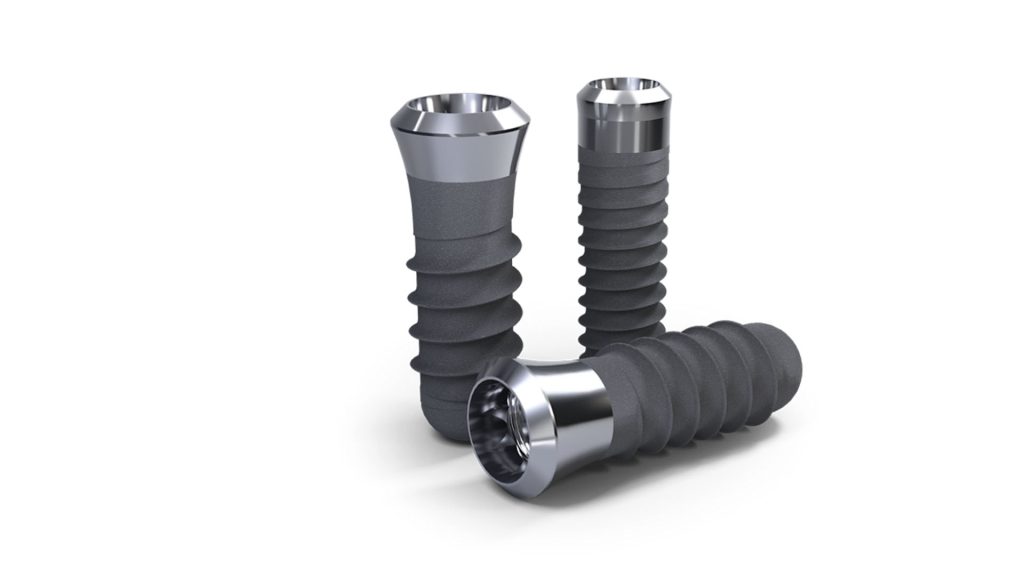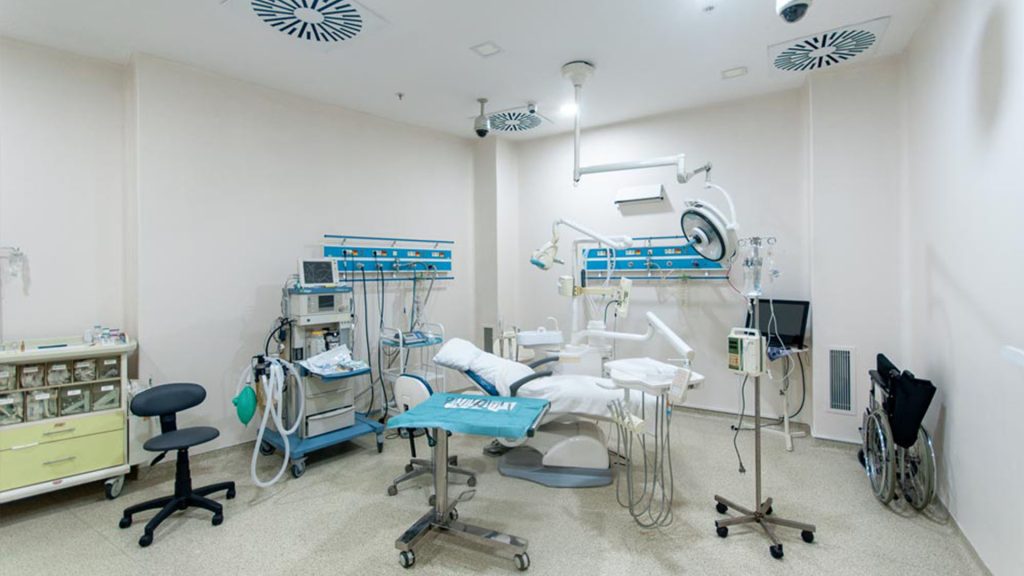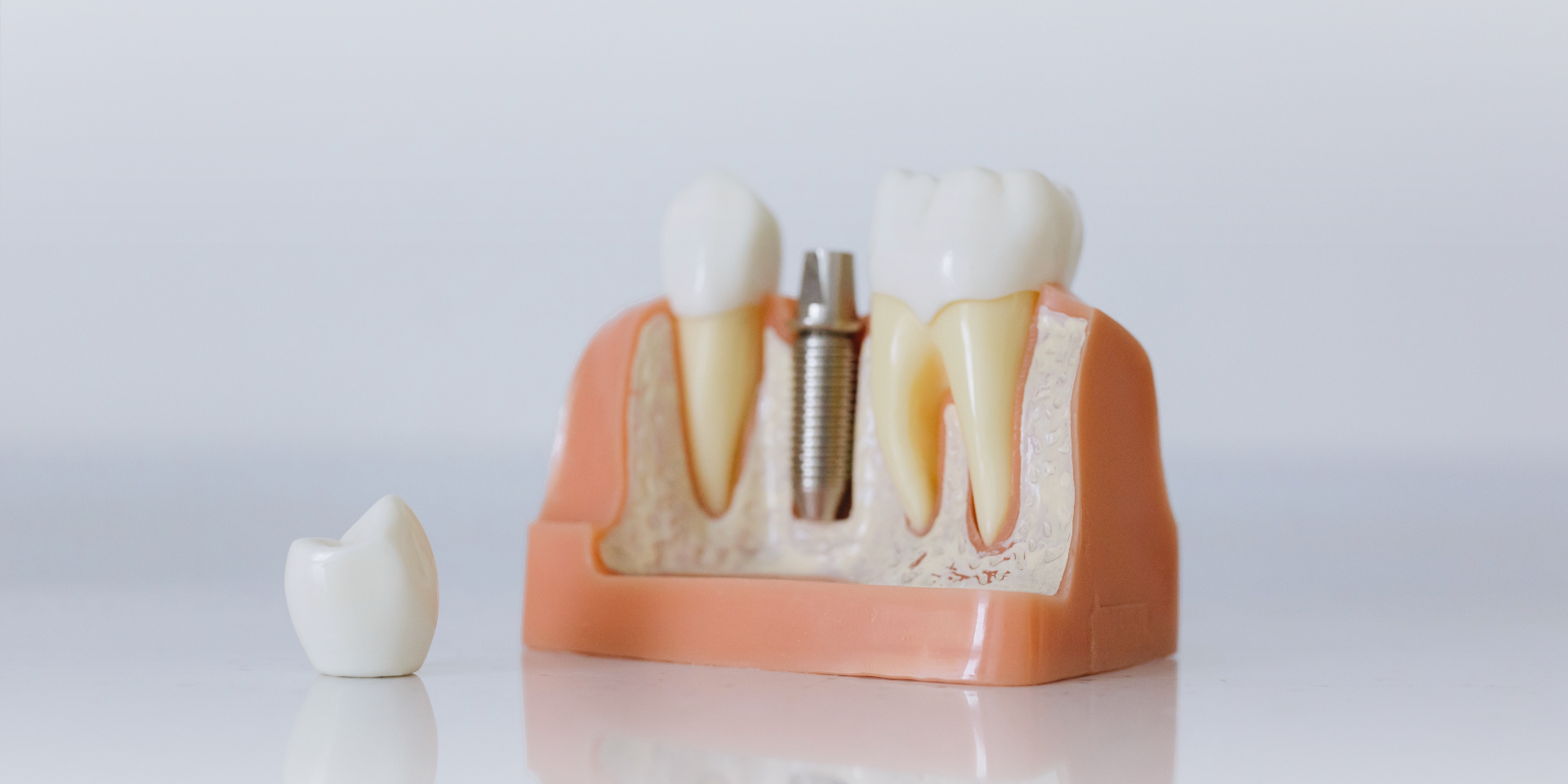What is implantology ?
Implantology, a branch of dentistry dedicated to dental implants.
The invention of dental implants
The history of dental implants begins in the 1950s, when Professor “Per Ingvar Brånemark” discovered the biocompatibility properties of titanium. Dr. Per Ingvar Brånemark decided to use titanium to treat edentulous patients. Thanks to this discovery This treatment is currently our reference treatment for missing teeth.
Dental Implants
A natural tooth has two main components: the crown which is the visible part of the tooth and the root which is the part of the tooth lodged in the jaw bone under the gum.
A dental implant acts like an artificial root of a tooth, as it is inserted into the jaw bone. It very often has the shape of a screw and is made of titanium or a titanium alloy which fuses with bone and functions as a tooth root.
Dental implants is made of titanium

Why titanium ?
Titanium is a high quality metal known to be well tolerated by the human body, especially by the bone. Over time, the bone forms again around the dental implant.
The characteristics of Titanium:
- Lightness.
- Resistance to Corrosion.
- Special Biocompatibility.
The Preimplantation Examination,
Before taking action, the dental surgeon takes note of your medical history and also chronic diseases are questioned and then proceeds to a complete examination. Indeed, the oral condition must be free from the slightest risk of infection which could hinder the placement of the implant.
He then performs a 3D X-ray in order to visualize a perfect vision of the bone structure of the maxillofacial part of the patient to determine the number of implants necessary, the place where it will be fixed, the appropriate crowns and also the materials. required.
During the preimplantation examination, the anatomical structures located near the region to be implanted, the nerves that control the semi-jaw of the lower jaw and the points that we call the mental nerve are examined, also many factors such as the Bone condition, existing and adjacent teeth, and oral hygiene are assessed.

Bone condition
When do we need a Bone Graft ?
As the implant must remain completely inside the bone in the area where it will be placed. Therefore, a certain length and width of the bone is necessary, if insufficient bone volume is observed during the x-ray images or the tomography images taken during the examination, bone augmentation applications will be applied, which we call bone augmentation or bone grafting, are necessary in this area because the bone level is the most important factor for the life of the implant in the mouth.
Existing and Adjacent Teeth
If existing and adjacent teeth have cavities or infected conditions, implantation should be performed once these issues are resolved. Since implants are non-living materials, they have no defense structure, so any infection of nearby areas will lead to loss of the implant. It is therefore necessary to carefully plan additional factors such as implant positions and gingival heights in order to build a harmonious structure.
Oral hygiene
Oral hygiene is one of the most important points of implant treatment. Since the defense mechanism of teeth is not in implants, poor oral hygiene will lead to bone loss, and bone loss will lead to implant loss in patients who have undergone implant treatment. If bone loss occurs at a severe level, it may not be able to be re-implanted in that area afterwards. For this reason, we should pay more attention to oral hygiene than when we have our own teeth.
How Many Implants Should I Have ?
If the bone structure is in good condition, all teeth in one jaw will be replaced on 6 implants in one jaw called “All on Six”. Thus for a totally edentulous mouth, 12 implants are sufficient in most cases, in cases where we cannot reach enough bone in the posterior regions of the mouth, we can also apply a system composed of 4 implants on a jaw called “All on Four”.
“If you’ve ever decided to dive into the ‘All on’ dental procedure, you might be wondering what the difference between (All-On-4) or (All-On-6) dental implants can be.”
All-On-4 Dental Implants
The “All-On-Four” dental implant method involves placing four implants per arch without grafting or sinus lift: two vertical implants in the front area and two angular implants in the back area. Thanks to angled implants, a stable distribution of prosthetic forces can be ensured.
All-On -6 Dental Implants
Provide a stronger and more stable base for the prosthetic dental arch, resulting in a longer lasting and more comfortable smile. By considering bite and chew mechanisms, additional stability and more even pressure distribution can help extend the life of your prosthetic arch.
The clearest difference between dental implants (All-On-4) and (All-On-6) is the number of implants placed in the mouth. However, All-on-6 is not always a better procedure than (All-On-4). Patients who do not have enough bone strength to withstand the pressure of the two additional dental implants may benefit more from the All-on-4 dental implant procedure.

Implantation under General Anesthesia, Sedation or Local Anesthesia
General anesthesia for the placement of dental implants
General anesthesia (or GA) is a medical act carried out in an operating theater subject to the presence of an anesthesiologist and which requires prior examinations and the patient’s permission. It is used to temporarily lose consciousness (similar to sleep) and the sensation of pain, to reduce fear, gag reflexes and procedural anxiety to perform the dental procedure, safely with optimal comfort.
In this process, the implantation is completed without any sensation within a period of 3-4 hours of full sleep. Then the patient entered the awakening process.
Intravenous sedation for the placement of dental implants
Local anesthesia with the addition of intravenous sedative allows the patient to doze off during the procedure and thus lose track of time, but the patient remains conscious throughout the procedure, he is able to answer the dentist’s questions. . It is an excellent solution against anxiety, making the intervention more comfortable.
Local anesthesia for the placement of a dental implant
The first proposal is local anesthesia, which is by far the most common anesthesia when it comes to placing a minimal number of dental implants. It is an anesthesia that consists of putting an area of the mouth to sleep in order to start the implantation procedure without the patient feeling any pain other than slight pressure.
The procedure time is on average 5 to 15 minutes for an implant. If there are additional treatments in the area, this period may be extended. The effect of anesthesia lasts 2-3 hours.

Dental Implant Steps
Dental Implant Placement
The surgical intervention is completely painless since it is carried out under local anesthesia, General anesthesia or intravenous sedation according to the choice of the patient and the opinion of the surgeon. Its duration varies according to the complexity of the operation.
First, a drill is made in the alveolar bone of the jaw in order to screw in an artificial root (Dental Implant). Then the intervention continues with the closure of the implant site with medical sutures.
Placement of a temporary prosthesis
One hour after implantation an intra-oral measurement is taken with “Dental Digital Scanner” which captures 3D digital dental impressions and uses the data to produce a more detailed image of the patient’s mouth and the temporary teeth can be placed in the same day of surgery.
Temporary prostheses are made of resin, this transitional solution is ideal in the event of a visible missing tooth and allows you to smile without embarrassment. In addition, it optimizes healing by ensuring the maintenance of the gum around the implant.
The osseointegration phase
After the successful placement of the implant and during the healing phase, the bone will regenerate and weld to the titanium surface, a biocompatible material, of the artificial root. This is an essential step for the success of the dental implant. Firmly anchored in the bone, it provides a fixed and solid base to support the prosthesis.
The Osseointegration Phase is a minimum 10-12 week process under normal conditions, if additional bone related applications such as bone grafting are done, the Osseointegration Phase may take up to 6 months.
Placement of the final prosthesis
After the healing period, an intra-oral measurement is taken using the “Dental Digital Scanner” digital impression, to design the prosthesis or the crowns in the dental laboratory.
Then, rehearsals are made in terms of harmony, color, and shape, and they are shaped according to the evaluation and feedback from the doctor and the patient. Then, the prosthesis is placed definitively.
Post-surgical instructions
After the dental implantation intervention there are instructions to which the patient must pay attention in the post-surgical process:
- Avoid eating and drinking for 2 to 3 hours until the effect of the anesthesia wears off.
- On the day of implantation, avoid movements that will create a vacuum in the mouth, such as rinsing and spitting. Because these movements will cause bleeding due to the removal of the clot that has formed there for healing.
- After implantation, the application of ice for 3-4 hours is important for the implanted areas to avoid swelling due to the operation in the bone. When applying
ice, it is necessary to apply at intervals of 10 minutes, otherwise ice burns may occur in the affected area. - Use the antibiotics, analgesics and mouthwash written in the prescription according to the instructions.
- It is normal to feel some slight swelling and pain in this area after implantation.
- Precautions must be taken to clean the installation areas.
- The mouthwashes provided must be used appropriately. The area should be cleaned with a soft brush after 2-3 days. Cleaning this area is very important for rapid wound healing. Debris such as leftovers can delay wound healing and cause you to feel pain.
- If it is necessary to remove the threads, it is mandatory to remove them between 7 and 10 days. Otherwise, the sutures may be the focus of infection in this area.
- Do not consume very hot or very cold foods and drinks during the healing process, soft foods should be your preference. The possibility of irritation in the wound area can come back to you with pain.
- If you pull on the wound areas, the stitches may open. Avoid this.
Do not smoke for 1 week, there should be blood cells in this area for healing. Since smoking reduces bleeding, it negatively affects wound healing. This process can lead to the loss of the implant.
Implant or Bridge?
Treatments that are advancing through technology and research in all parts of the world are continually increasing the number of successful applications in oral health.
In this context, implant treatments are increasing their success rate day by day. With the right material and the right applications, implant treatments have become the gold standard in the treatment of missing teeth. Previously, dental deficiencies were resolved with the bridge system, but the long-term success of this procedure is not as high as that of the implant.
In the application of a bridge, a missing tooth is treated with a 3-limbed bridge by making a cut in the adjacent teeth and building on those teeth. With this cutting process we have to wear the enamel tissue that protects the tooth from external factors. This shortens the life of the tooth in question. At the same time, the force that 3 teeth have to resist in this area must now be carried by the 2 teeth there.
In the same case, if the implant is placed, the missing tooth will be completed in the most appropriate way to replace the missing tooth, without any abrasion being necessary on the adjacent teeth. Since there is no loss of tooth surface and they can share force, the life of healthy teeth will also be extended.
Dental Implantation and Diabetic Patients
If the 3-month HbA1 blood glucose value is too high, the probability of successful implantation decreases significantly due to problems caused by wound healing. First, reduce the risk in terms of diabetes, then perform the treatments that significantly increase the success of the implantation.
Dental Implantation and Cardiac Patients
In case of heart disease, previous operations and blood pressure problems, a specialist doctor is consulted after the treatment will be decided. It is necessary to make a good planning by knowing the risk factors. The development and evolution of implant treatments.
Similar Cases


